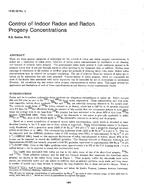Description
There are three general categories of techniques for the control of radon and radon progeny concentrations in indoor air — restriction of radon entry, reduction of indoor radon concentrations by ventilation or air cleaning, and removal of airborne radon progeny. The predominant radon entry process in most residences appears to be pressure driven flow of soil gas through cracks or other openings in the basement, slab, or subfloor. Sealing these openings or ventilation of the subslab or subfloor space are methods of reducing radon entry rates. Indoor radon concentrations may be reduced by increased ventilation. The use of charcoal filters for removal of radon gas in indoor air by adsorption has also been proposed. Concentrations of radon progeny, which are responsible for most of the health risks associated with radon exposures, can be controlled by use of electrostatic or mechanical filtration. Air circulation can also reduce radon progeny concentrations in certain cases. This paper reviews the application and limitations of each of these control measures and discusses recent experimental results.
Units: Dual
Citation: Symposium, ASHRAE Transactions, 1985, vol. 91, pt. 2B, Honolulu, HI
Product Details
- Published:
- 1985
- Number of Pages:
- 17
- File Size:
- 1 file , 1.7 MB
- Product Code(s):
- D-HI-85-39-3




